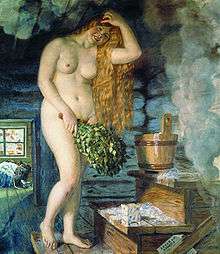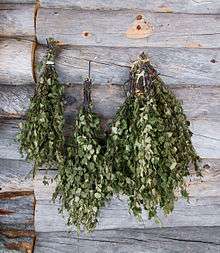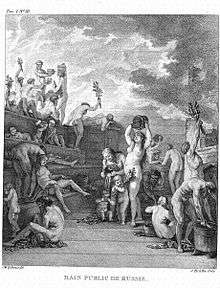Banny venik

Bath broom (Russian: банный веник, Russian pronunciation: [ˈbannɨj ˈvʲenʲɪk]; Finnish: vasta or vihta) is a besom, or broom, used in Russian bathhouses,[1] or banyas, and in Finnish saunas.
A bath broom is typically made with the branches and leaves of a tree or shrub which secretes aromatic oils. The branches and leaves are then dried and tied around a wooden handle.[2] The broom is used to massage a bather's skin and generate heat.
Types
The bath broom can be made out of almost any tree or shrub whose twigs are sufficiently flexible, have no thorns, and do not emit any sticky or harmful substances.
Different species of plants are believed to have different effects on humans. Some brooms are meant to have a soothing, relaxing, soporific effect, such as birch, oak, eucalyptus and Gukanov’s combined. Others are meant to have a stimulating effect, such as rowan and tansy. All, however, can be used for thalassotherapeutic massage.

Birch bath brooms help to ease muscle and joint pain after exercise and physical activity, clear skin rash, accelerate the healing of wounds and bruises, and have an overall calming effect on the body. Its main effect is the expansion of the bronchi to the steam in saunas, thus promoting discharge of phlegm and aiding lung function. It is helpful for asthmatics and smokers. Birch leaves contain essential oils, tannins, vitamin C, and provitamin A. After a massage with a birch bath broom, the skin becomes smooth, firm, and gains a more pleasant color. A scalp infusion can be used at the end of the sauna session to strengthen the hair and eliminate dandruff.
Oak bath brooms are more suitable for people with oily skin, as they help to dry the skin and make it firmer. They have a strong anti-inflammatory effect. The oak aroma prevents blood pressure from rising too much in the sauna. Oak leaves contain large amounts of tannins. An oak infusion can be used as a remedy for certain skin diseases and sweating feet. It calms the nervous system after physical and mental exercise.
Tilia, otherwise known as basswood, lime, or linden, is used to relieve headaches. It also has a diuretic effect with a mild effect on the kidneys, accelerates sweating, and has a soothing, healing, antipyretic effect on the body that helps to expand the bronchi.
Alder bath brooms are generally used to cure colds, as well as muscle and joint pain.
Pine bath brooms must be steamed in boiling water for ten minutes, and can be used once they have become soft. It is useful to add one or two pine twigs to birch and oak brooms. The infusion can be used on the rocks or for washing.
Fir tree bath brooms are used during the winter in Siberia, while juniper bath brooms are used in Central Asia. The resinous substances found in these plants irritate the skin, stimulate sweating, and increase blood circulation deep in the muscles and even in the internal organs. This type of bath broom is usually used for specialized massages, e.g. for back pain, neuralgia, and sciatica. It also sanitizes the air and prevents respiratory infections.
Fir tree and juniper bath brooms cannot be made in advance, as the needles dry up and fall off, and thus must be used fresh.
Eucalyptus bath brooms are often used in the Caucasus. A eucalyptus leaf contains around 1%-3% essential oils, which account for its therapeutic properties. It is particularly useful for colds and sore throats. In the sauna, the broom is usually pressed against the face while breathing through the nose for four to five minutes. However, eucalyptus branches are thin and flexible, and the leaves are longer than other plants, so a eucalyptus bath broom is very difficult to control during the massage.
Morning bath brooms made with rowan leaves and tansy stimulate the nervous system, eliminating the relaxing effect of the sauna and preparing the body to work, which is why it is usually used in the first half of the day.
Nettle bath brooms are used to treat joint, muscle, or lower back pain after exercise. Nettle has a powerful local irritant, anti-inflammatory effect, and can be used as a remedy for sciatica, rheumatism, and gout. When used regularly, it reduces blood pressure and eliminates nervous tension. However, if whipped with force, the leaves quickly become damaged and unusable. The broom is normally dipped in hot water for a few seconds and used only after warming up the body with light strokes. Nettle is a well-known remedy for fractures, sprains, bruises, hematomas, etc. specifically due to its burning properties.
Gukanov’s combined bath brooms are a combination of oak, linden, birch and juniper twigs, with the juniper twigs usually hidden within the broom. It is usually stored in the attic, laid out on the floor in several rows on top of one and other, with dry brooms at the bottom and wet brooms at the top, or hung during rainy weather. This storage method is troublesome, but it keeps the broom flat, in the shape of a fan, and easy to use. Storing it in the dark helps it keep its aroma, color, and freshness, as the leaves lose their color and smell when exposed to light.
Maple, walnut, ash, and elm can also be used to make bath brooms, as can young shoots of the cherry tree, cut early in summer. Bundles of any herb, including medicinal or aromatic ones, can be added as well. In summer, usually only entirely herbal brooms are used, including those used for rubbing. Seasonal bath brooms should be used fresh, as they contain a lot of essential oils and phytoncides.
Preparation
Birch bath broom
According to an old tradition, bath brooms are usually prepared after Pentecost, which takes place fifty days after Easter, usually in the first half of June. At this time of year, birch trees in different parts of Russia may be in different stages of their annual cycles. Therefore, it is necessary to pay attention to the stage of maturation of plants, when the leaves are the most robust. Bath brooms must be prepared on a dry day. Breaking the brooms takes place in the first half of the day, after the dew.
The weeping birch tree is suitable for making bath brooms. Typically, these trees are tall, with very flexible, with long, spongy twigs. The best option is a young birch tree that has never bloomed before, since it will have the most tender leaves. The top side of the leaf should not be rough, but soft and velvety, while the branches should be thin and straight. The leaves will contain the highest possible concentration of beneficial substances.
The twigs are first tied together loosely. They are then hung on a pole or a rope stretched under a canopy so they avoid direct sunlight. This should be done in a place with a good draft. After six or seven days, when the twigs are well dried, they are tied together tightly. The brooms are then densely stacked on shelves in a dry, well-ventilated place.
It is best to form the broom into the shape of a fan and not a broom. In order to do this, the fresh twigs should be laid on the floor and turned over every day until they are dry. The brooms should not be dried out too much.
Studies have shown that the best quantity and quality of therapeutic substances in bath brooms (including birch brooms) is achieved by following traditional methods of storing medicinal plants. Tightly tying fresh twigs together will result in the central leaves losing color, darkening, and smelling as if burnt.
The broom should be woven after clearing the handle of leaves and small twigs. Then, the desired number of twigs is wrapped with string, while the left hand holds the twigs together. It is important to lay thicker branches on the inside, and the thin, curved ones around them. This makes the bath broom sturdier and it will be able to last several sauna sessions.
Bath brooms should be stored in a haystack. Prepared branches can be stored in the dark in winter, in the form of a sheaf, and tied up whenever needed. In both cases, the leaves are better preserved.
The oak used for making bath brooms is cut down between June and August in a humid, dark forest. The branches are dried and tied in the same way as the birch bath broom. A correctly dried bath broom should have perfectly green leaves and smell of balsamic birch oil. The smell should increase greatly after steaming the broom. Large shoots are very flexible and thus pleasant to use on the body in the sauna.
Bath Broom Massage

If the broom is fresh, it is used immediately without prior steaming. Otherwise, it will become soft.
A dry bath broom should first be lowered for ten to twenty minutes into cold water, and then for on to three minutes into hot water.
Very dry bath brooms need to be steamed more. This is done by placing the broom in a covered bowl of water. The bowl is then dipped into a bowl of hot water for one to three seconds, while rotating and shaking the bowl containing the broom. After this is repeated two or three times, the broom should be ready after one to two minutes.
The optimal position in the sauna for the bather is the prone position.
During the massage sessions, some guidelines should be adhered to: The bath broom should be kept moist by being periodically dipped into warm water; movements of the bathhouse attendant should be subtle, as the broom should provide a massaging effect.
This type of massage increases blood circulation, causing a redistribution of blood, lymph and interstitial fluid throughout the body. Any new bath broom will secrete phytoncides, which kill harmful bacteria. The essential oils in the leaves and twigs improve metabolism and prevent premature aging of the skin.
See also
References
- ↑ "History of Dry Russian Sauna". Chicago Sweatlodge. Retrieved 2015-09-04.
- ↑ "Stuccu: Best Deals on Sauna venik Buy Exclusive Deals 70 OFF Save Big Lowest Price On Sauna venik Best In Stock Fast Free Shipping. Up To 70% off!". stuccu.com. Retrieved 4 September 2015.
Further reading
- Всё О Бане. Banya Reference Guide